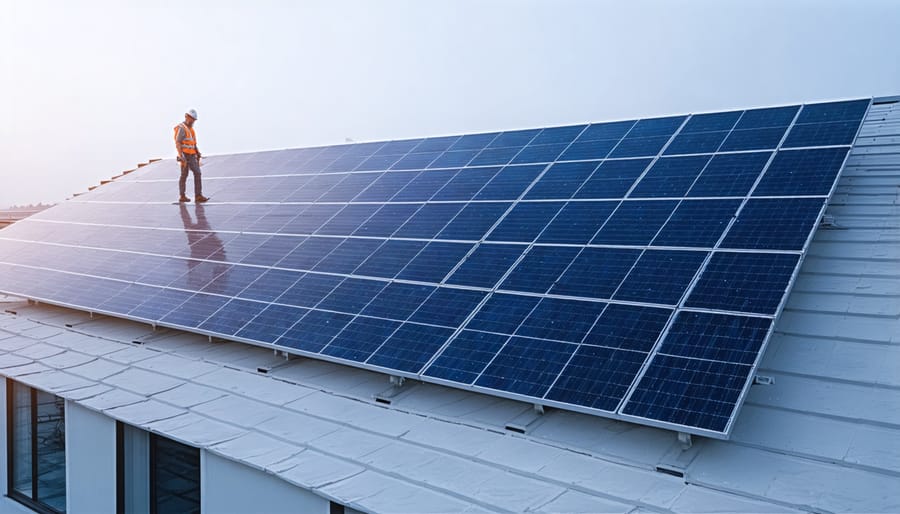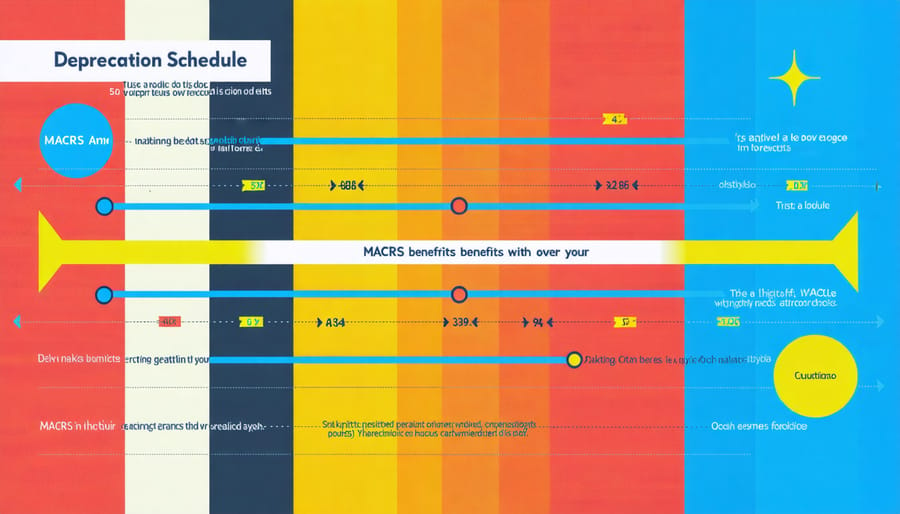Solar Tax Benefits That Make Corporate Energy Projects Pay Off Faster
Solar energy investments offer some of today’s most substantial tax benefits for both homeowners and businesses, with incentives that can offset up to 30% of installation costs through the federal Investment Tax Credit (ITC). Smart companies leveraging solar technology now save millions annually while building sustainable energy portfolios that attract environmentally conscious customers and investors.
The complex interplay between state rebates, federal credits, and depreciation allowances creates powerful financial opportunities, yet navigating these tax structures requires careful planning. Property owners who understand and maximize these incentives often achieve payback periods under five years while securing decades of reduced energy costs.
Recent legislative changes have expanded and simplified solar tax benefits, making 2024 an optimal time to invest in renewable energy infrastructure. From accelerated depreciation options to performance-based incentives, today’s solar tax landscape offers unprecedented advantages for forward-thinking organizations ready to embrace clean energy solutions.

Federal Solar Investment Tax Credit (ITC) for Businesses
Current ITC Rates and Timeline
The Investment Tax Credit (ITC) for solar energy systems currently offers substantial savings through available tax incentives and rebates. For installations completed in 2024, property owners can claim a 30% tax credit on their solar system costs. This rate will remain stable through 2032, providing an excellent opportunity for long-term planning and investment.
Starting 2033, the rate will step down to 26%, followed by a decrease to 22% in 2034. Unless Congress extends the program, the residential credit will expire in 2035, while commercial installations will retain a permanent 10% credit.
To qualify for these rates, projects must either be completed within the specified year or meet the “commence construction” requirements. This means having started physical work or investing at least 5% of the total project cost.
For maximum benefit, homeowners and businesses should plan their installations well in advance of these deadlines, ensuring all paperwork and installations are properly documented for tax filing purposes.
Qualifying Expenses and Requirements
The federal solar tax credit covers a wide range of expenses related to your solar energy system installation. Equipment costs, including solar panels, inverters, wiring, and mounting hardware, are all eligible for the credit. Labor costs for on-site preparation, assembly, and professional installation are also qualifying expenses.
Battery storage systems installed with your solar panels qualify when charged exclusively by solar power. Additional qualifying costs include permitting fees, inspection costs, and developer fees. Even indirect expenses like structural engineering services and freight shipping charges can be included in your tax credit calculation.
For homeowners, the cost of necessary roof repairs or reinforcement directly related to solar installation may qualify. However, general roof repairs or aesthetic improvements aren’t eligible. Energy monitoring systems and smart home devices specifically designed for your solar setup are typically covered.
Remember that qualifying expenses must be paid within the tax year you’re claiming the credit. Keep detailed records of all costs, including receipts, contracts, and installation documentation. This paperwork is essential for accurately calculating your credit and supporting your claim if needed.
State-Level Solar Tax Incentives
Popular State Programs
Several states lead the way with generous solar energy incentives, making renewable energy more accessible than ever. California’s Solar Initiative offers substantial rebates, while New York’s NY-Sun program provides appealing state-specific solar incentives for both residential and commercial installations. Massachusetts shines with its SMART program, offering production-based incentives that can significantly reduce installation costs.
Hawaii’s Green Energy Money Saver (GEMS) program helps homeowners finance solar projects with flexible payment options. In New Jersey, the Successor Solar Incentive Program (SuSI) rewards solar adopters with performance-based incentives. Illinois stands out with its Adjustable Block Program, providing upfront incentives that can cover up to 30% of installation costs.
Arizona and Nevada offer net metering programs, allowing solar users to earn credits for excess energy production, while Oregon’s Solar + Storage Rebate Program combines solar installation support with battery storage incentives.

How to Stack Multiple Incentives
Maximizing your solar investment starts with understanding how to combine multiple incentives effectively. The federal solar tax credit can be paired with state-level incentives, local utility rebates, and property tax exemptions to significantly reduce your overall costs.
Start by claiming the federal Investment Tax Credit (ITC), which offers a 30% deduction on your solar installation costs. Then, layer on state-specific incentives, which vary by location but often include additional tax credits or rebates. Many states also offer Solar Renewable Energy Certificates (SRECs) that you can sell for extra income.
For commercial installations, accelerated depreciation benefits can be combined with both federal and state incentives. Remember to carefully document all expenses and maintain proper records for each incentive program. Work with a qualified tax professional to ensure you’re maximizing available benefits while staying compliant with program requirements.
Don’t forget to check with your local utility company for additional rebates or performance-based incentives that can stack with tax benefits.
Depreciation Benefits for Solar Investments
MACRS Depreciation Schedule
The MACRS (Modified Accelerated Cost Recovery System) depreciation schedule offers solar energy system owners a valuable tax benefit by allowing them to deduct the system’s cost over time. Under this system, most solar energy equipment qualifies for a 5-year depreciation schedule, which means you can recover your investment faster than with traditional depreciation methods.
Here’s how it works: In the first year, you can deduct 20% of the system’s cost, followed by 32% in year two, 19.2% in year three, 11.52% in year four, 11.52% in year five, and 5.76% in year six. This accelerated depreciation schedule significantly reduces your taxable income during the early years of your solar investment.
For commercial property owners, MACRS depreciation can be combined with other solar incentives, like the Investment Tax Credit (ITC), to maximize financial benefits. However, when using both incentives, the depreciable basis is reduced by half the value of the ITC received.
Remember to consult with a qualified tax professional to ensure proper implementation and documentation of your MACRS depreciation claims.

Bonus Depreciation Options
Beyond standard depreciation methods, businesses investing in solar energy systems can take advantage of bonus depreciation options that significantly accelerate their tax benefits. As of 2023, the IRS allows qualified solar equipment to be eligible for 80% bonus depreciation in the first year of service. This means you can immediately write off a substantial portion of your investment, dramatically improving your ability to calculate your solar ROI more favorably.
For commercial installations placed in service through 2025, this accelerated depreciation option can be combined with other available tax incentives, such as the Investment Tax Credit (ITC). However, it’s important to note that bonus depreciation rates will continue to phase down: 60% in 2024, 40% in 2025, and 20% in 2026, before being completely phased out in 2027.
Small and medium-sized businesses can particularly benefit from this option, as it helps offset the initial installation costs more quickly and improves cash flow during the crucial early years of solar investment. Consider consulting with a tax professional to determine the optimal depreciation strategy for your specific situation.
Tax Planning Strategies for Solar Projects
Timing Your Solar Investment
The timing of your solar investment can significantly impact your tax savings and overall return on investment. With the recently extended federal Investment Tax Credit (ITC) offering 30% savings through 2032, now presents an excellent opportunity to go solar. However, several factors should influence your decision on when to start your project.
Consider installing your system before the end of the tax year if you’re looking to claim credits on your next return. Remember that the ITC applies to the year your system becomes operational, not when you start the installation process. Plan for a timeline of 3-6 months from initial consultation to final activation.
Weather conditions can also affect installation efficiency and costs. Spring and fall typically offer ideal conditions with moderate temperatures and clearer skies, potentially reducing installation time and costs. Summer installations might cost more due to peak demand, while winter installations could face weather-related delays.
Keep an eye on state and local incentive programs, as these often change annually. Some regions offer additional tax breaks or rebates that complement federal incentives, but many operate on a first-come, first-served basis with limited funding. Consulting with a solar tax professional can help you identify the perfect timing sweet spot that maximizes available incentives while meeting your energy needs and budget constraints.
Remember that equipment prices tend to fluctuate throughout the year, with potential deals during off-peak seasons or end-of-year sales. By strategically timing your purchase, you can combine optimal pricing with maximum tax advantages.
Working with Tax Professionals
Navigating solar energy tax incentives can be complex, which is why assembling the right team of tax professionals is crucial for maximizing your benefits. Start by seeking a certified public accountant (CPA) who has experience with renewable energy projects and federal tax credits. These specialists can help you understand how solar investments will impact your overall tax situation.
Consider working with a tax attorney who specializes in energy tax law, particularly if you’re planning a large-scale commercial installation. They can provide valuable insights into structuring your solar investment to optimize tax advantages while ensuring compliance with current regulations.
Many solar installation companies partner with tax professionals who understand both the technical and financial aspects of solar projects. Ask your installer for recommendations, but always verify credentials and experience independently.
When selecting your tax team, look for professionals who stay current with changing tax laws and renewable energy policies. They should be able to explain complex concepts in simple terms and provide clear documentation for all tax-related decisions.
Schedule regular consultations with your tax team, especially during the planning and installation phases of your solar project. They can help you maintain proper records, meet filing deadlines, and ensure you’re taking advantage of all available incentives. Remember to keep them informed about any changes to your solar system or energy usage patterns that might affect your tax situation.
The path to sustainable energy and financial savings through solar power has never been more accessible. Tax incentives at federal, state, and local levels make solar installations increasingly attractive for both homeowners and businesses. By taking advantage of these tax benefits, you can significantly reduce your initial investment while contributing to a cleaner environment.
Remember, the solar Investment Tax Credit, accelerated depreciation, and various local incentives can combine to cover up to 60% of your solar project costs. Don’t wait to explore these opportunities – tax incentives may change over time, and acting sooner ensures you maximize your benefits.
Take the first step today by consulting with a qualified solar installer or tax professional. Your investment in solar energy isn’t just about saving money; it’s about building a sustainable future while enjoying substantial tax advantages. Make solar energy work for you, your wallet, and our planet.











